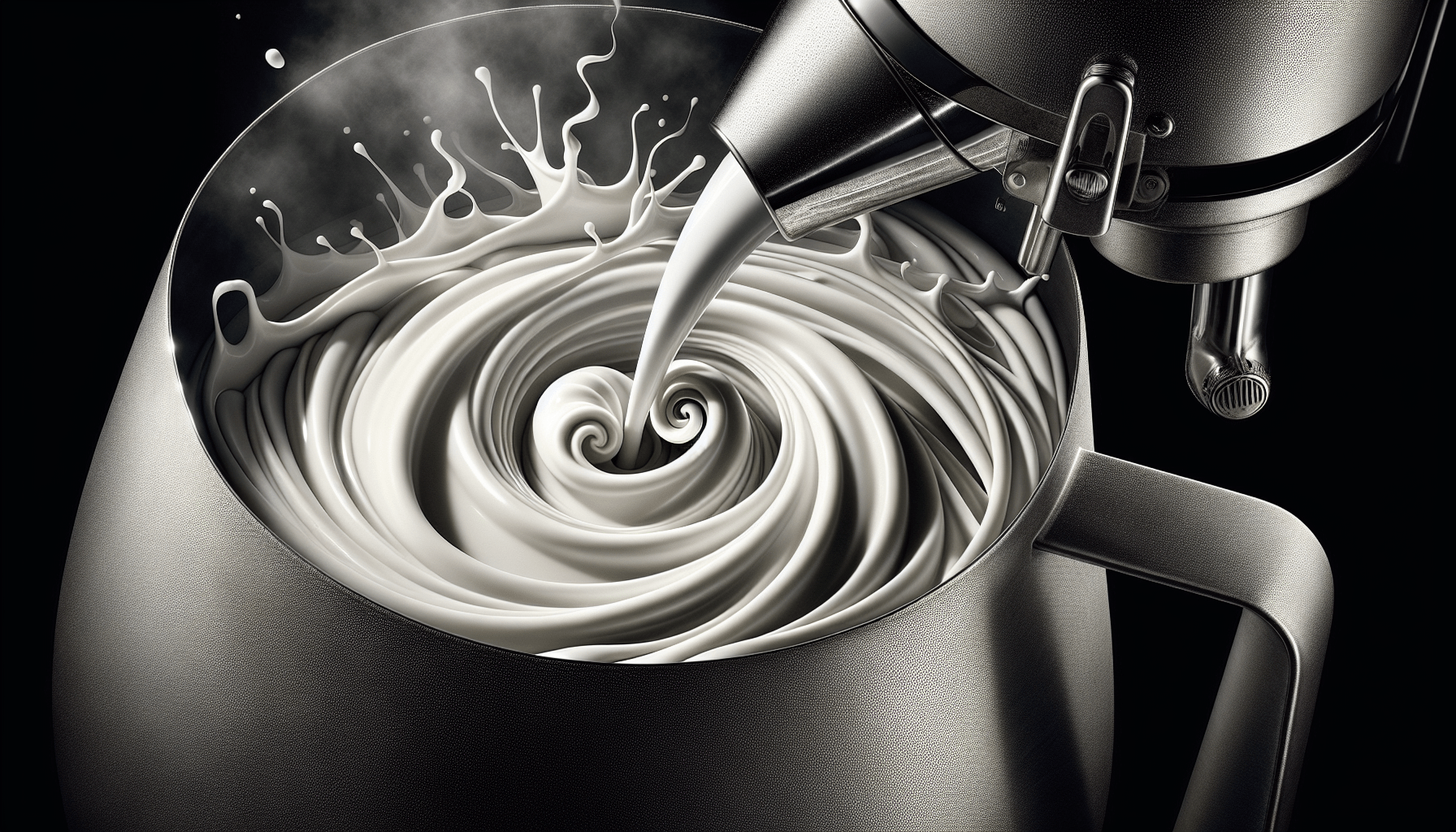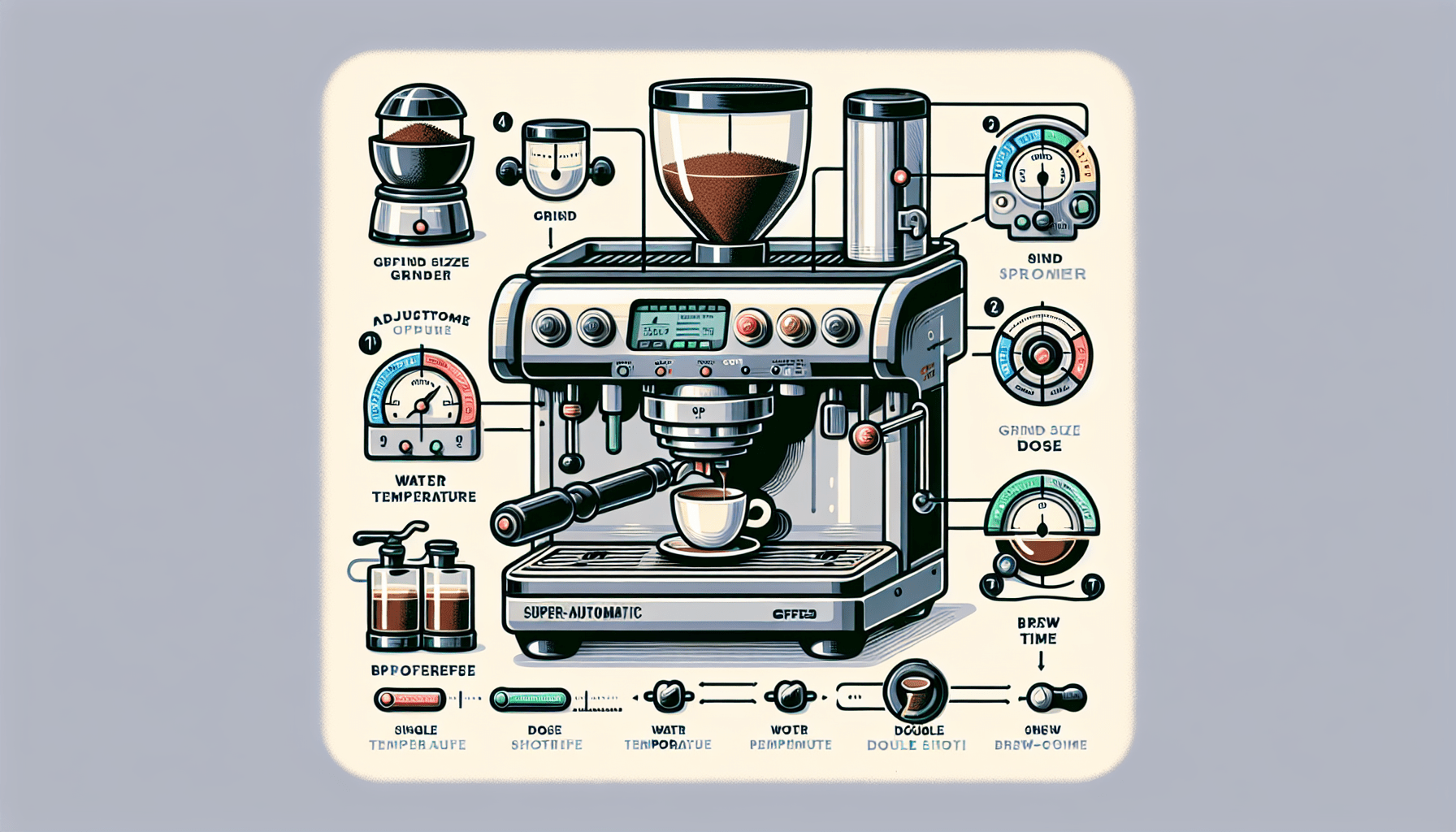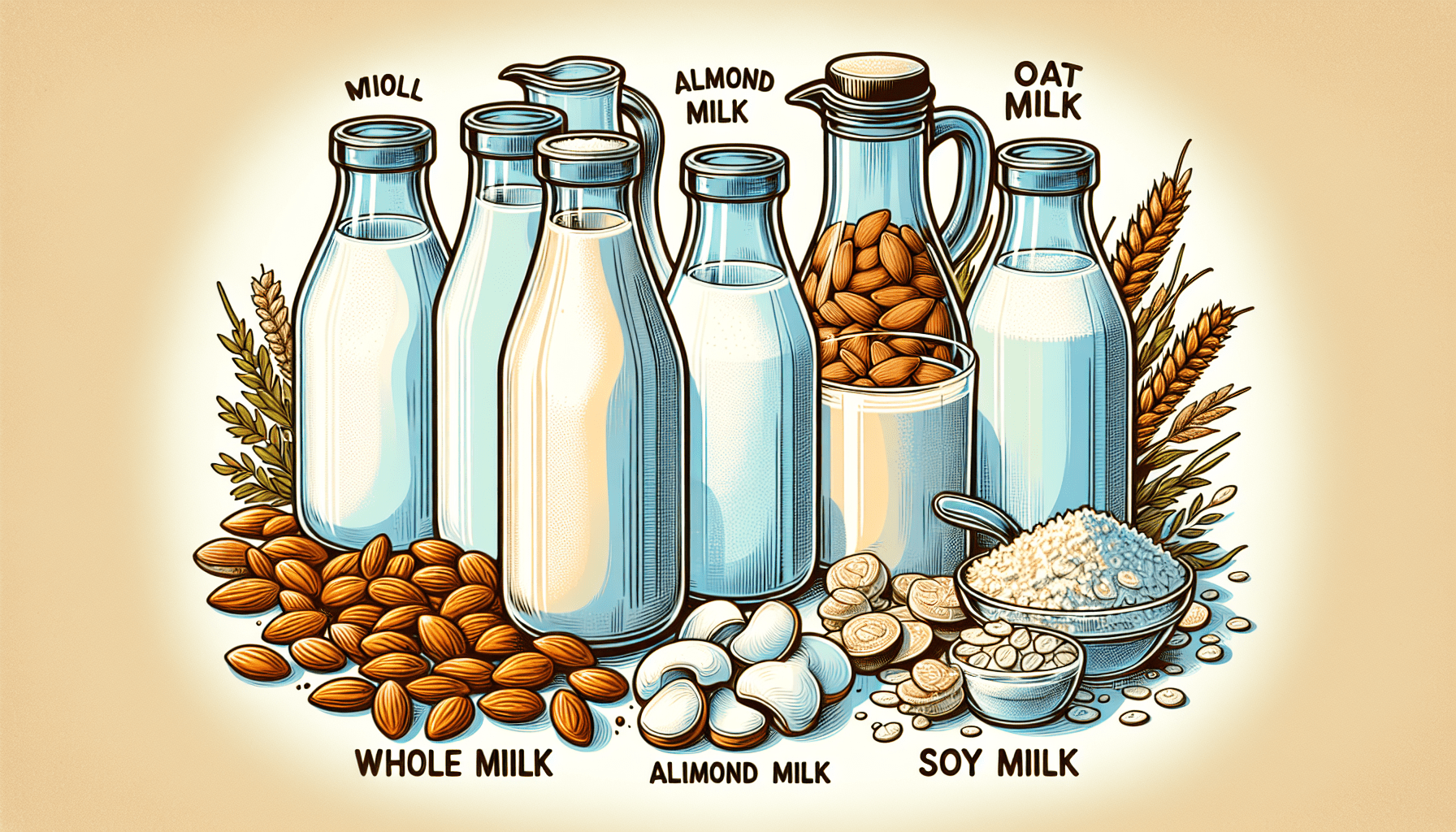Have you ever wondered how those deliciously creamy and velvety milk-based drinks are made in a super-automatic espresso machine? Well, wonder no more! In this article, we will delve into the inner workings of the milk frothing system in these impressive machines and explore the fascinating process behind creating that perfect froth. Get ready to discover the secrets behind this essential component of your favorite coffee beverages.
Overview of Milk Frothing System
Definition of milk frothing system
A milk frothing system is a crucial component of espresso machines, particularly in super-automatic models. It is responsible for creating the creamy and velvety milk froth that is essential for various espresso-based drinks. The milk frothing system consists of several components and operates through a step-by-step process, resulting in the perfect froth consistency.
Importance of milk frothing in espresso machines
Milk frothing plays a vital role in espresso machines as it enhances the taste, texture, and overall experience of espresso-based beverages. The frothed milk adds a creamy and velvety touch to drinks like cappuccinos and lattes, elevating their flavor profiles. Without a proper milk frothing system, the quality of these beverages would be compromised, leading to less satisfying coffee experiences.
Components of Milk Frothing System
Steam wand or frother
One of the primary components of a milk frothing system is the steam wand or frother. This attachment allows steam to be injected into the milk, creating micro-bubbles and eventually transforming it into froth. The steam wand/frother can be maneuvered to achieve the desired froth consistency, allowing for customization and control over the frothing process.
Water reservoir and heating element
The water reservoir and heating element are crucial components that work together to provide the necessary steam for frothing the milk. The water reservoir stores water that is heated by the heating element. The heated water then turns into steam, which is used to froth the milk. This process ensures that the milk is heated and foamed to perfection.
Milk container or carafe
To facilitate the milk frothing process, super-automatic espresso machines often come equipped with a milk container or carafe. This container holds the milk and is connected to the frothing system. It allows for easy and convenient frothing, as the milk is dispensed directly from the container into the steam wand or frother.
Pressure valves and sensors
Pressure valves and sensors are vital components that ensure the milk frothing system operates smoothly and safely. These valves regulate the steam pressure within the system, preventing excessive pressure buildup and potential accidents. Sensors also monitor the temperature of the milk and the consistency of the froth, ensuring optimal results.
Control panel or touch screen
Modern super-automatic espresso machines are equipped with a control panel or touch screen interface that allows users to adjust and control various aspects of the milk frothing system. This panel or screen provides options to set the desired froth consistency, monitor the frothing process, and customize the settings according to personal preferences.
Step-by-step Process of Milk Frothing
Preparing the milk container
Before beginning the milk frothing process, it is essential to prepare the milk container. This involves ensuring that the container is clean, free of any residue or leftover milk. Additionally, it is necessary to choose the appropriate container size, depending on the quantity of milk needed for the desired drink.
Setting the desired froth consistency
The next step is to set the desired froth consistency. This can be done through the control panel or touch screen interface, where options such as “foamy,” “creamy,” or “extra frothy” may be available. Choosing the right froth consistency allows for customization and ensures that the resulting froth complements the specific drink being prepared.
Activating the steam wand or frother
Once the milk container is prepared and the desired froth consistency is selected, it is time to activate the steam wand or frother. This is typically done by pressing a button or engaging a specific function on the control panel. Activating the steam wand initiates the steam production, which is essential for frothing the milk.
Heating and foaming the milk
As the steam wand or frother is activated, the heating element in the espresso machine begins to heat the water in the reservoir. Once the water reaches the appropriate temperature, it turns into steam and is injected into the milk container through the steam wand. The steam causes the milk to heat up and creates a foaming effect, transforming it into froth.
Monitoring the frothing process
Throughout the frothing process, it is important to monitor the milk closely. This can be done by observing the milk container or carafe, ensuring that the froth is forming evenly and consistently. Monitoring also allows for adjustments to be made in real-time, such as pausing the frothing process or adjusting the froth consistency if necessary.
Types of Milk Froth
Microfoam
Microfoam is a type of milk froth characterized by its velvety texture and small, dense bubbles. It is often used in latte art, as its smooth consistency allows for intricate designs to be created. Microfoam is achieved by frothing milk with a steam wand or frother while maintaining a precise balance of steam pressure, milk temperature, and frothing technique.
Cappuccino foam
Cappuccino foam is another type of milk froth commonly used in cappuccinos. It is characterized by its thick and creamy texture, with larger bubbles compared to microfoam. Cappuccino foam is achieved by frothing milk with a higher steam pressure and allowing the frothing process to continue for a slightly longer duration.
Latte foam
Latte foam is similar to cappuccino foam but with a lighter and less dense texture. It is achieved by incorporating more air into the milk during the frothing process, resulting in slightly larger bubbles and a less creamy consistency. Latte foam is commonly used in latte beverages, adding a layer of froth on top of the espresso and steamed milk.
Hot milk
Apart from frothed milk, the milk frothing system also allows for the heating of milk without creating foam. This is useful for drinks like hot chocolate or simply warming milk for those who prefer a non-frothy option. The milk frothing system can warm and heat the milk to the desired temperature, providing the versatility to cater to different preferences.
Factors Affecting Milk Frothing
Milk temperature
The temperature of the milk plays a crucial role in achieving the desired froth consistency. Different types of milk require different temperatures for optimal frothing. For example, whole milk generally froths best at temperatures around 140°F (60°C), while non-dairy alternatives like soy or almond milk may require slightly lower temperatures.
Milk fat content
The fat content of the milk also affects the frothing process. Milk with a higher fat content, such as whole milk, tends to froth more easily and produces a creamier froth. Conversely, milk with lower fat content, like skim or non-fat milk, may result in a thinner and less dense froth. Experimenting with different milk types allows for customization based on personal preferences.
Frothing speed and duration
The speed and duration of the frothing process contribute to the resulting froth consistency. Frothing too quickly may result in large bubbles and a less creamy texture, while prolonged frothing beyond the optimum point can lead to over-foaming or scorching of the milk. Finding the right balance of speed and duration is key to achieving the desired froth quality.
Steam pressure
Steam pressure is a critical factor that affects milk frothing. Higher steam pressure provides more force to aerate the milk and create larger bubbles, resulting in a thicker froth. Lower steam pressure, on the other hand, produces a finer and smoother froth. Super-automatic espresso machines often allow users to adjust the steam pressure, offering versatility and control.
Frothing technique
The technique used during the milk frothing process greatly influences the final result. Properly positioning the steam wand or frother in the milk, angling it correctly, and maintaining a consistent movement are essential techniques for creating the desired froth. Practice and experimentation are necessary to master the frothing technique and achieve consistent results.
Maintenance and Cleaning of Milk Frothing System
Regular cleaning of steam wand
Regular cleaning of the steam wand or frother is essential to ensure optimum performance and prevent the buildup of milk residue or bacteria. After each use, it is recommended to wipe the steam wand with a clean cloth or sponge to remove any milk residue. Additionally, periodic deep cleaning with warm, soapy water and a brush is necessary to thoroughly clean the wand.
Removing milk residue and build-up
Over time, milk residue and build-up can accumulate within the milk container or carafe, affecting the frothing process and compromising hygiene. To remove this residue, it is important to disassemble the milk container and clean all its components, including the lid, spout, and tubes, with warm, soapy water. Thorough rinsing and drying are necessary before reassembling the container.
Descale and maintenance routines
In addition to regular cleaning, descaling is a vital maintenance routine for the milk frothing system. Over time, mineral deposits from the water used in the espresso machine can accumulate within the system, affecting its performance. Using a descaling solution specifically designed for espresso machines can effectively remove these deposits, ensuring optimal frothing performance.
Troubleshooting Common Issues with Milk Frothing
No froth or insufficient froth
If the milk frothing system is not producing any froth or if the froth is insufficient, several factors may be at play. It is crucial to check if the steam wand or frother is properly inserted into the milk container, as a loose connection may impede the frothing process. Additionally, ensuring that the milk is fresh and at the correct temperature can also contribute to better frothing results.
Excessive froth or overflow
Excessive froth or overflow can occur if the frothing process is not monitored closely. Frothing for too long or using excessive steam pressure can cause the milk to over-foam and spill over the edges of the container. Proper timing, adjusting the steam pressure, and closely monitoring the frothing process can help avoid excessive froth or overflow.
Milk scorching or burning
Milk scorching or burning can happen if the milk is not properly heated or if the frothing process is prolonged beyond the optimum duration. To prevent scorching, it is important to monitor the milk closely and stop frothing once the desired temperature is reached or the froth consistency is achieved. Adjusting the frothing technique and using a thermometer can help avoid milk scorching.
Steam wand blockage
A blocked steam wand or frother can prevent the milk frothing system from functioning properly. Blockages can occur due to milk residue or mineral deposits. If the steam wand is not producing steam or if the milk is not frothing as expected, it is crucial to check for blockages. Using a thin brush or pin to clear any obstructions and thoroughly cleaning the steam wand can resolve this issue.
Tips and Techniques for Perfect Milk Frothing
Choosing the right milk
Choosing the right milk is crucial for achieving the best frothing results. Whole milk generally froths better and produces a creamier texture compared to lower-fat milks. However, various non-dairy alternatives, such as soy, almond, or oat milk, can also produce excellent froth when selected based on their specific frothing properties. Experimenting with different milk options allows for personal preference and customization.
Using chilled milk
Using chilled milk can contribute to better frothing results. Cold milk maintains its structure better during the frothing process, resulting in a finer and denser froth. Cold milk also allows for a longer frothing duration without scorching, providing more control over the froth consistency. Pre-cooling the milk in the refrigerator before frothing can enhance the overall frothing experience.
Creating latte art
One of the joys of frothing milk is the opportunity to create latte art. Latte art involves using the frothed milk to create intricate designs on the surface of the beverage. To create latte art, it is necessary to achieve a microfoam consistency that is smooth and velvety, allowing for better control and definition in the art. Mastering frothing techniques and practicing latte art designs can result in visually stunning beverages.
Experimenting with frothing techniques
Frothing techniques can greatly impact the final result. By experimenting with different techniques, such as varying the angle of the steam wand or frother or adjusting the speed of the frothing process, it is possible to achieve different froth consistencies and textures. Additionally, exploring different patterns while frothing, such as swirling or rocking the milk container, can create unique froth effects.
Benefits of Super-Automatic Espresso Machines with Milk Frothers
Convenience and ease of use
Super-automatic espresso machines with milk frothers offer convenience and ease of use, making them suitable for coffee enthusiasts of all skill levels. With the touch of a few buttons, users can froth milk effortlessly, eliminating the need for manual frothing techniques or additional appliances. The automated nature of these machines simplifies the process and allows for consistent results without extensive training.
Consistent and precise milk froth
Super-automatic espresso machines with milk frothers ensure consistent and precise milk froth with every use. By incorporating advanced technology, these machines can control various factors such as steam pressure, milk temperature, and frothing duration, resulting in reliable and reproducible froth consistency. This consistency allows users to enjoy their favorite beverages with the same quality each time.
Time-saving and efficient
The integration of a milk frothing system in super-automatic espresso machines saves time and enhances efficiency. Frothing milk manually can be time-consuming and requires focus and skill. With a milk frothing system, the process is automated and significantly faster, allowing users to enjoy their espresso-based beverages in a shorter amount of time. This time-saving feature is particularly beneficial for busy mornings or when entertaining guests.
Versatility and customization
Super-automatic espresso machines with milk frothers offer versatility and customization options. Users can choose from various froth consistencies, milk types, and temperatures, allowing for a personalized coffee experience. Additionally, these machines can accommodate different cup sizes and dispense the desired amount of froth, catering to individual preferences and specific drink recipes.
Conclusion
In conclusion, the milk frothing system in super-automatic espresso machines is a critical component that elevates the quality and enjoyment of espresso-based beverages. By understanding the components, step-by-step process, and factors affecting milk frothing, users can achieve the perfect froth consistency for their preferred drinks. Regular maintenance and troubleshooting ensure optimal performance, while tips and techniques enhance the frothing experience. The benefits of super-automatic espresso machines with milk frothers, such as convenience, consistency, and customization, make them a worthwhile investment for coffee lovers seeking café-quality milk froth in the comfort of their homes. So, whether you prefer a creamy cappuccino or a beautifully adorned latte, the milk frothing system in your super-automatic espresso machine will help you create the perfect froth and enjoy a delightful coffee experience.




